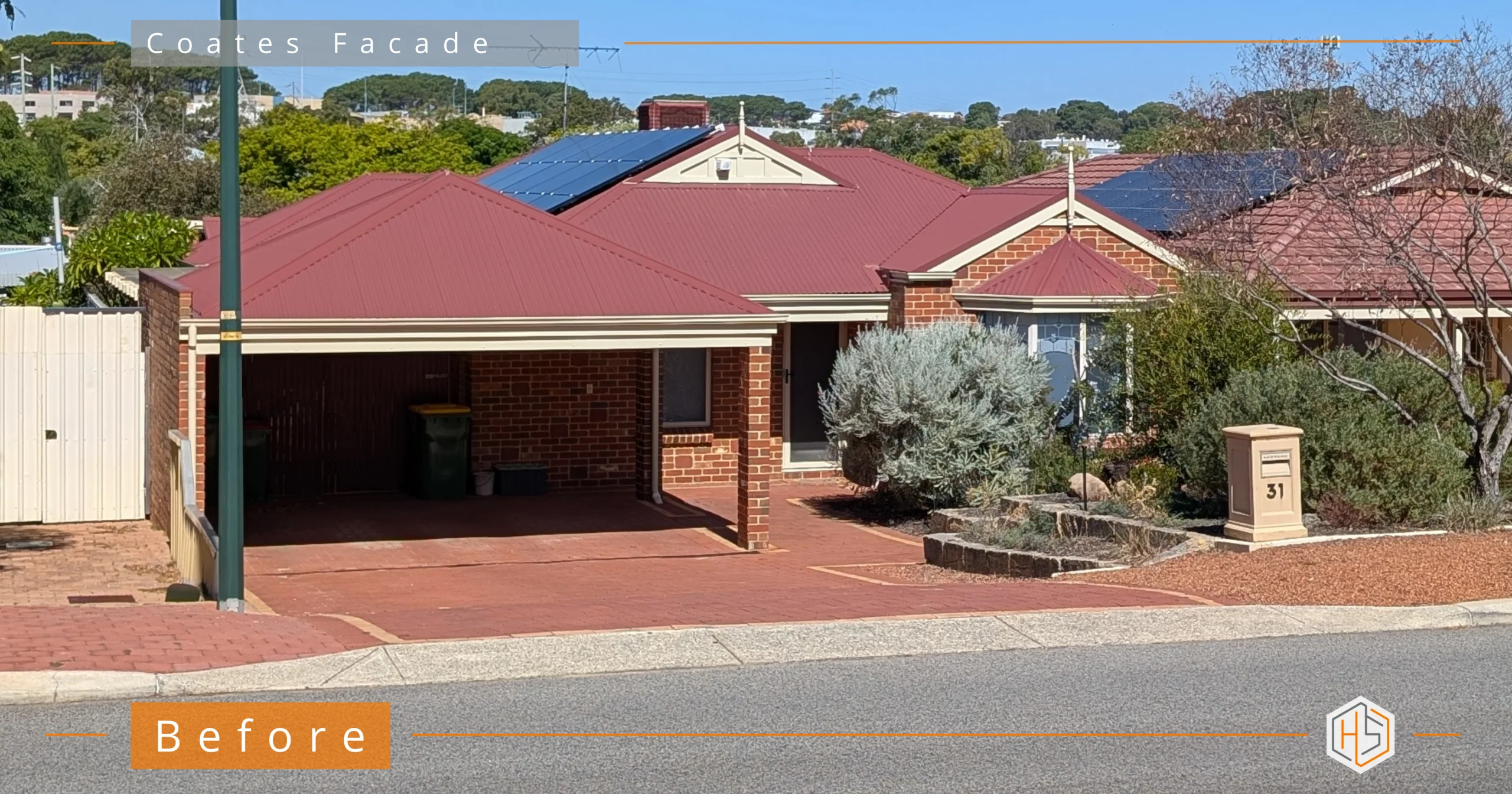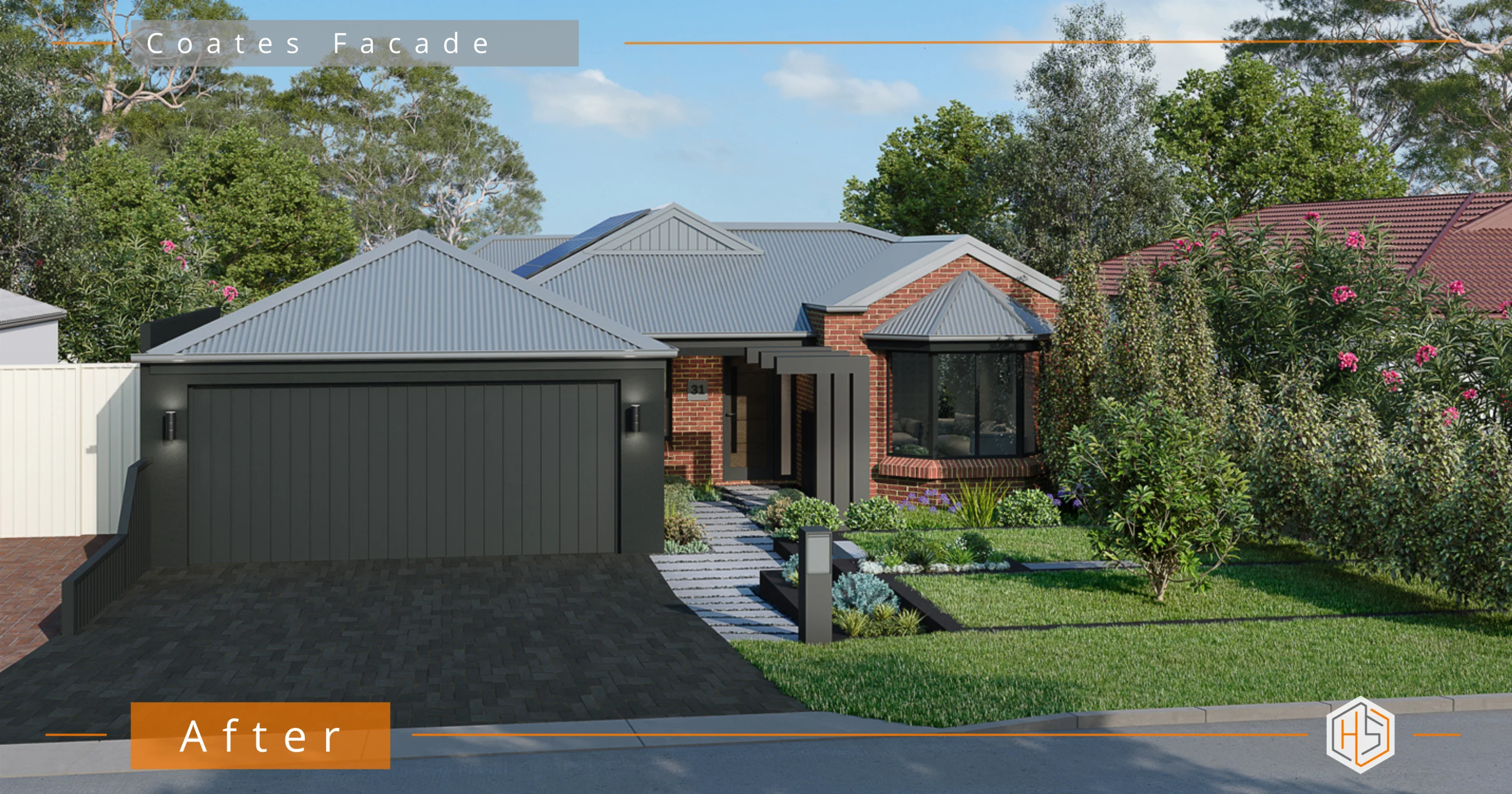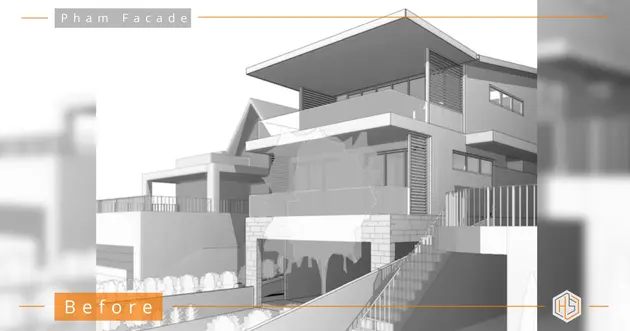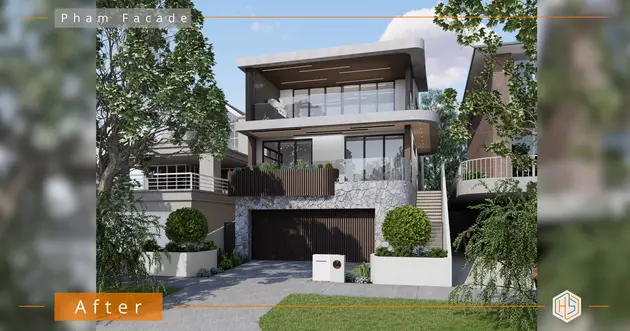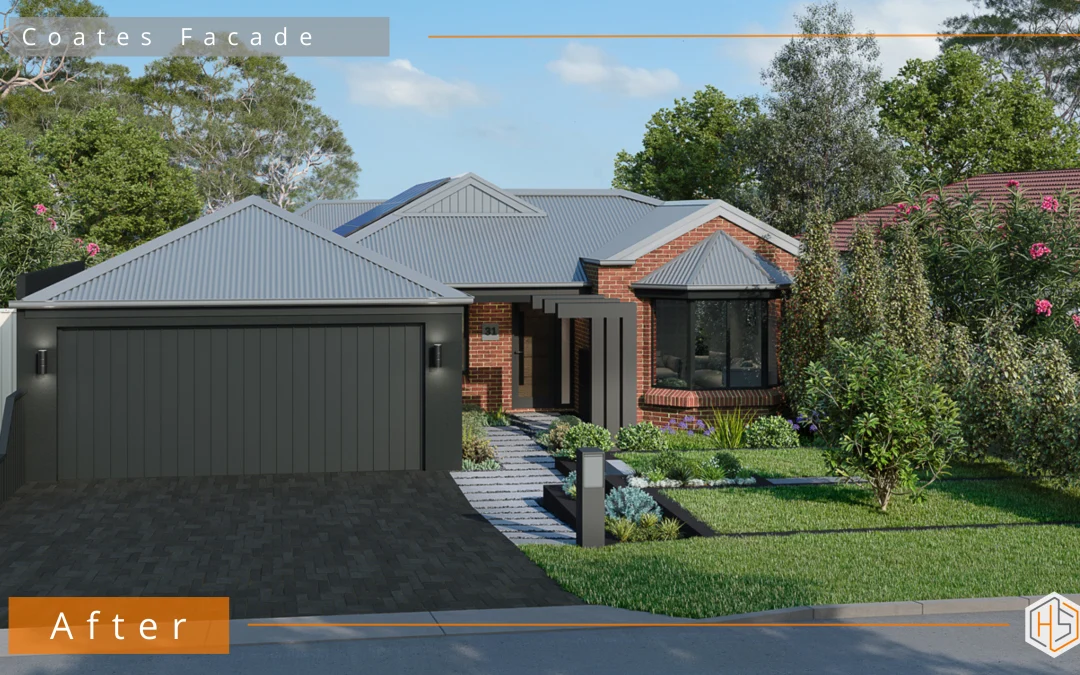
If you live in Australia, chances are you’ve seen (or lived in!) a home with red brick, a red roof, and a red driveway. It was a popular style in its day — but today, all that red can make your home look heavy, dated, and difficult to work with.
👇👇Designed by Hotspace👇👇
The good news is, you don’t need to render the entire house or rip everything out. With a few smart updates, you can tone down all that red and completely refresh your facade.
Why All That Red Feels Overwhelming
Red brick has a strong, dominant tone — and when you combine it with a red roof and red driveway pavers, it’s just too much of the same thing. There’s no visual relief, no contrast, and no balance. The result? A home that feels stuck in the past.
Here’s what I recommend to modernise the look while keeping the parts you want to retain.
1. Recolour the Roof
Start by updating the roof colour. A mid to dark grey or muted earthy tone will dramatically reduce the visual intensity of the red brick and bring your home into the present. This one change can make your entire facade feel more balanced and refined.
2. Tone Down the Driveway
If your driveway is red-tinted concrete or red pavers, consider recolouring or resurfacing it in a neutral shade. A soft charcoal or warm grey works beautifully to ground the home without competing with the red brick.
3. Work With the Brick
If you’re not rendering your brick (and many homeowners choose not to), then it’s all about what you put around it. Use neutral tones — like charcoal, greige, black or creamy white — for trims, garage doors, gutters, and entry features. This contrast helps balance the warmth of the brick and stops the whole facade from blending into one red mass.
4. Add Greenery
Lush landscaping is a fantastic way to soften the look of a red brick home. Green foliage contrasts beautifully with warm tones and adds life and depth to your front yard. Consider feature plants, climbing vines, or structured hedges to break up the red visually.
5. Create a Visual Anchor
Adding a new architectural feature — such as a portico, timber battens, or rendered pier — in a contrasting material gives your facade a fresh focal point. It helps draw attention away from the red and creates a more intentional, curated look.
Toning down a red brick house isn’t about hiding the brick — it’s about giving it the right support. A fresh roof colour, new driveway finish, and well-chosen accents can all work together to modernise and elevate your home’s appearance.
If you’re not sure where to start, I can help. I’ve designed facades for homes all across Australia — completely online — with customised plans that suit your budget, your brick, and your style.
Get in touch here or follow me for more design tips and facade makeovers.
Jane
A well-thought-out modern fence design isn’t just a boundary — it’s a defining element of your home’s facade. Whether you’re after privacy, security, or simply street appeal, a contemporary fence can elevate your entire exterior design when done right.
👇👇Designed by Hotspace👇👇
Two common types of front fences (and why they matter)
- Solid or Rendered Fences with Inset Details
These are popular for their clean lines and strong visual presence. Think smooth rendered finishes paired with accents like stone cladding, vertical timber or aluminium battens, or brass inlays. They create a sense of permanence and privacy while offering plenty of scope to tie in with your home’s architectural elements.
- Open-Style Batten or Post Fences
For a more breathable, light-filled look, vertical battens or slim posts in timber-look aluminium or powder-coated steel offer a contemporary feel without blocking the view entirely. These styles define your property’s edge and still allow landscaping to shine through, especially when the house is set further back from the street.
Defining your property — with style
Fences serve a practical purpose: they define your front boundary, deter unwanted visitors, and give structure to your landscape. But in modern fence design, they also play a key aesthetic role. A front fence should complement your house, not compete with it.
Choose materials that mirror or echo the finishes used on your facade — whether that’s matching stone cladding, render colours, vertical timber accents, or even brass hardware. These connections help your entire exterior feel cohesive and considered.
If you’re including a driveway gate or pedestrian gate, these should be integrated seamlessly into the overall design. Keep them in line with your chosen material palette and proportions so they don’t feel like an afterthought.
Height matters
The height of your fence should feel proportionate to your home’s position on the block. A general rule of thumb: the closer the house is to the street, the lower the fence should be — if practical. This keeps the frontage feeling open and welcoming, rather than defensive or boxy.
Always check your local council regulations before you start. Some areas have restrictions or overlays that limit fence height or materials, and certain covenants may even prohibit front fences altogether.
Colours, numbers & details
The colour of your fence should enhance the look of your home — not steal the spotlight. Avoid bold contrast shades that draw too much attention to the boundary. Instead, opt for tones that sit harmoniously within your home’s palette, allowing the entrance to remain the hero.
House numbers, mailboxes, intercoms and even lighting can be the final flourish that elevates your fence from standard to stunning. Brass or matte black numbers are timeless, and built-in mailboxes or niches can keep everything streamlined.
And don’t underestimate the power of greenery. A row of lush grasses, clipped hedges or flowering shrubs in front of your fence can soften hard lines and make the whole frontage feel more inviting.
What’s ‘In’ (and what’s ‘Out’)
IN:
-
Solid rendered fences with clean, inset detailing
-
Vertical battens (timber, timber-look, or aluminium)
-
Stone cladding or stone-look detailing
-
Brass, black or white hardware and house numbers
-
Integrated mailboxes and minimal gates
-
Subtle lighting and soft landscaping
OUT:
-
Horizontal slats (once popular, now looking tired)
-
Patchwork materials with no design linkage to the house
-
Overly high fences that overwhelm the home
-
Chunky columns and outdated caps
-
Shiny stainless steel finishes
-
Busy, overdecorated gates
Final Thought
A modern fence design is not just a barrier — it’s the first impression your home gives. Choose well, and it will frame your property beautifully while enhancing your overall facade. Remember, the magic is in the details — so make every element count.
hotspaceconsultants.com/preliminary-enquiry/
Jane Eyles-Bennett
Let’s face it—most home facade designs don’t exactly stop traffic. Stale brickwork, mismatched colours, and dated materials can drag your entire house down. But here’s the thing: a facade renovation isn’t just about paint. It’s a full transformation that breathes new life into your home, skyrockets kerb appeal, and gives you that wow-factor you see in the best neighbourhoods.
If you want proof, check out my gallery of real front facade transformations—it’s inspiration gold.
1. Harness Texture for Home Facade Architectural Impact
Texture is the secret sauce that takes a flat, unimpressive exterior and gives it depth—sometimes it’s the difference between forgettable and fabulous. Time and again, I see homes that look like blank canvases, just crying out for layers.
- Seamlessly combine smooth rendered surfaces with vertical cladding—this breaks up dull expanses and instantly updates the facade
- Add timber accents—think feature battens or panelling—to introduce warmth and sophistication
- Balance brickwork with concrete-effect or matte finishes for a contemporary look
By carefully mixing textures, you’re not simply modernising, you’re creating architectural interest that draws every eye.
2. Refresh Your Colour Scheme the Right Way
Too often, I see homeowners overwhelmed by colour charts—thinking it’s just about picking a few shades. But for real street appeal, your facade colour scheme NEEDS to work with the architectural features, not against them.
- Choose crisp whites, timeless off-whites, and subtle greys for your main surfaces—these neutrals never age
- Layer in darker tones like charcoal or deep black for contrast and drama—especially around window frames and entryways
- Embrace natural timber elements as your ‘colour’, weaving in warmth without overwhelming the space
The right colour scheme is about cohesion. A well-chosen palette can turn even the most basic frontage into a standout statement.
3. Update Your Entrances for Maximum Street Appeal
Let’s be real—the front door and entry zone are where first impressions are made (or lost). A home facade renovation isn’t complete unless the entry has gravitas. That wow-factor.
- Opt for statement doors in solid timber or sleek, matte finishes
- Frame the entrance with modernist vertical cladding or a feature portico
- Use carefully positioned, architectural lighting to highlight textures and details
When the approach to your home is deliberate and inviting, you set the tone for the entire property—before anyone’s even stepped inside.
4. Integrate Modern Materials—Intelligently
Modern materials are there to add more than function—they boost visual interest and elevate your home’s value in one go. But successful facade design means knowing how to combine products, not just picking whatever’s on trend.
- Use rendered finishes to soften harsh old brick and achieve a fresh, modern look
- Vertical or horizontal cladding panels break up boxy shapes and add sleekness
- Mix matte black for trims—think gutters, window surrounds, or even garage doors—for a sharp, contemporary edge
The hottest facades you see (yes, even those new builds finally getting it right) all have one thing in common: clever use of contrasting materials—and a cohesive vision tying it all together.
Looking for transformation ideas tailored to your home? See more detail here: Exterior Facelift & House Facade Renovation.
5. Don’t Underestimate Professional Home Facade Design
Here’s the good news: You don’t have to gamble your renovation budget on guesswork. Quality facade design is strategic, blending your taste and lifestyle with proven design principles—so you avoid expensive mistakes and end up with a look you adore.
- Personalised design concepts give you confidence at every stage
- A cohesive facade design creates harmonious street appeal, not a mishmash of styles
- Thoughtful planning means your tradespeople (tradies!) know exactly what to deliver—no confusion, no regret
And best of all? You get peace of mind, knowing your investment is adding serious value both now and into the future.
Let’s be honest—pulling together a cohesive front facade renovation takes more than a Saturday afternoon and a paint swatch. The right design direction makes all the difference (and avoids those costly do-overs).
- Personalised, done-for-you design concepts focused on street appeal and resale value
- Detailed plans and trusted material recommendations
- Access to industry know-how—without the overwhelm
- Real-world case studies to inspire and guide your decisions
Ready to modernise your home and create a showstopping facade? Get in touch today and fill in our enquiry form. Upload photos of your home and let’s see how we can help transform your property into a standout home you’ll love for years to come.
Jane https://hotspaceconsultants.com/preliminary-enquiry/

A modern home design starts with strong bones—crisp lines, bold angles, and minimalist layouts. But left untouched, those sharp forms can feel a little cold, a little impersonal, and sometimes… a little underwhelming.
With the right combination of natural materials and thoughtful design details, even the most basic modern home façade can be elevated into something truly sculptural, warm, and luxurious. See examples of these transformations in our gallery.
👇👇Designed by Hotspace👇👇
Here’s how I approach it.
1. Let Stone Do the Heavy Lifting
Natural stone instantly adds weight and authenticity to a modern home exterior. I’m not talking about the old-school ‘stack stone’ — I mean refined, textural stone that works in harmony with the building’s geometry.
Used in the right areas—garage surrounds, garden walls, or front elevation piers—stone brings depth and grounding. It balances all the crisp lines and glass with something timeless and tactile.
2. Timber for Warmth (and Wow Factor)
Smooth render and glass can look sleek, but they need something to warm them up. Vertical timber battens or timber-look cladding add texture and rhythm without fuss. They help break up large expanses of façade and draw the eye exactly where you want it to go.
Even a small touch—like timber lining boards on a soffit—can add an unexpected layer of luxury.
3. Think in Sculptural Layers
A successful façade isn’t just a flat surface—it should unfold in layers. Balconies, overhangs, angled walls and recesses all create movement and allow materials to play off each other.
Don’t be afraid to lean into the geometry. Curve a roofline. Cantilever a balcony. Let the shadows cast by a feature wall become part of the design.
A truly modern home will already have these opportunities built in—you just need to highlight them.
4. Don’t Neglect the Details
Lighting. Landscaping. Even your letterbox. They all matter. When you’re dealing with a clean, modern structure, it’s the little things that elevate the whole picture.
Layered garden beds with sculptural planting, minimal but striking lighting, and that perfect hit of black hardware—it’s these subtle details that tie the entire look together and make it feel complete.
Final Thoughts
Modern homes have massive potential. But to bring them to life, they need more than just clean lines and a coat of paint.
By layering in natural materials like stone and timber, embracing sculptural form, and obsessing over the details, you can transform a cold, boxy structure into a warm, sophisticated masterpiece.
If you’re looking to take your home from stark to striking, this is exactly where to start. And if you’re not sure how to pull it all together, that’s what I’m here for. Send me an enquiry via the link below.
Jane Eyles-Bennett
https://hotspaceconsultants.com/preliminary-enquiry/
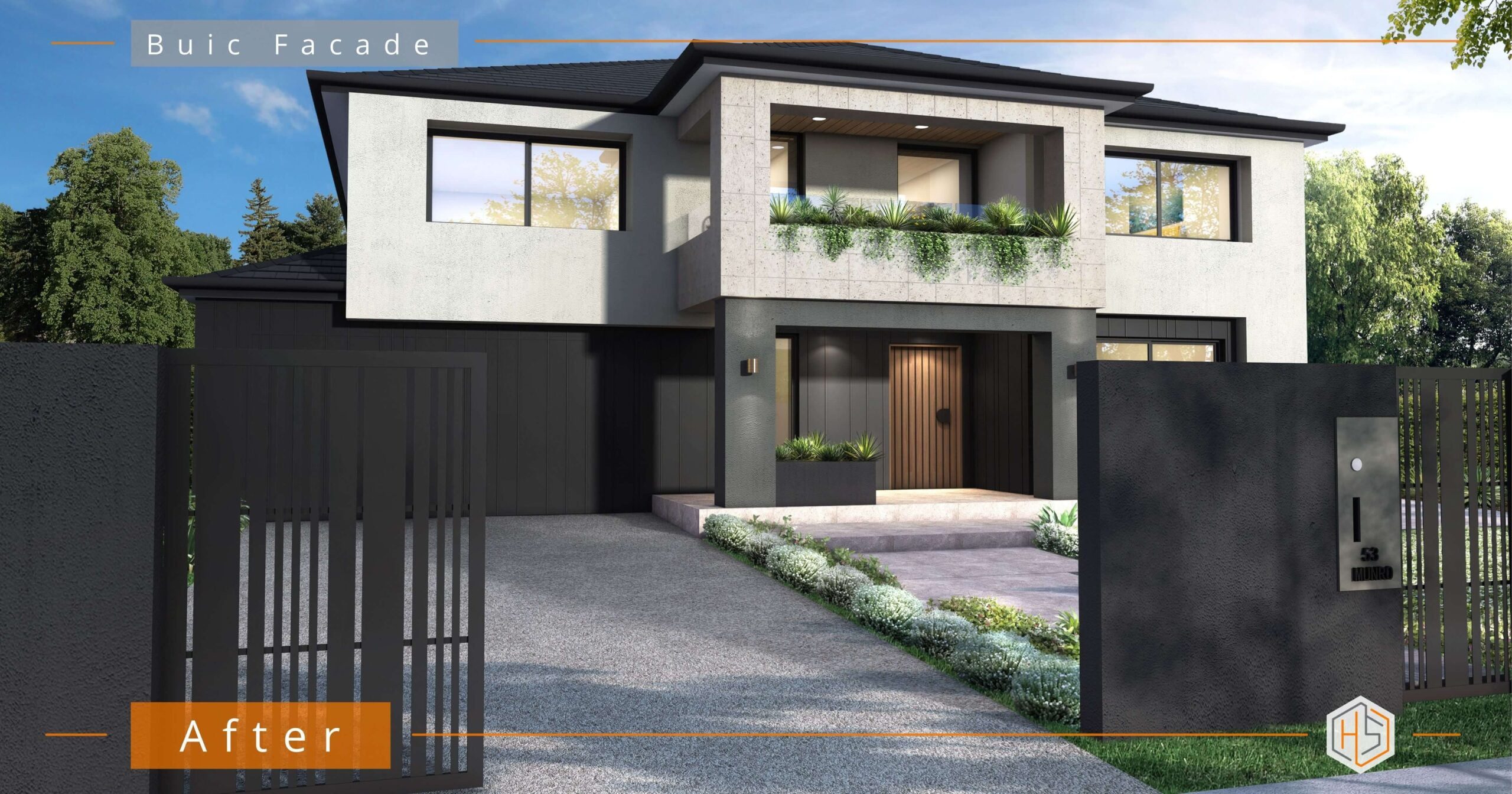
Modern home design has come a long way in terms of functionality, efficiency and clean aesthetics — but too often, it still misses the mark when it comes to personality. Take a drive through any new estate and you’ll likely see it: a sea of homes that all look the same. Boxy shapes, dark bricks, flat facades — technically modern, but lacking warmth and individual style.
👇👇Designed by Hotspace👇👇
Why So Many Homes Feel ‘Flat’
Many newly built homes are created with budgets, timelines and resale in mind. Developers and builders are focused on efficiency — which often means stripping design right back to the bare minimum. While this approach can streamline construction, it also tends to result in homes that feel impersonal and underwhelming.
Modern home design should be about more than ticking off trends. It should reflect the people who live in the home, and elevate the street it sits on.
What’s Missing From So Many Modern Facades?
Some of the most common issues with uninspired exteriors include:
-
Flat, repetitive materials (like black or charcoal brick used wall-to-wall)
-
A lack of texture or variation in finishes
-
Entryways that don’t feel defined or welcoming
-
Minimal contrast in colour palette
-
Balconies or upper levels that feel visually heavy
-
Little-to-no landscaping to soften the design
How to Fix It — Without Major Structural Changes
The good news is, it doesn’t take a full knockdown-rebuild to turn a basic facade into something beautiful. Thoughtful modern home design can transform the look and feel of your property through creative use of materials, finishes, and structure.
Here are a few key changes that make all the difference:
1. Add Visual Layers
A mix of textures — like smooth render, concrete-look cladding, timber accents or vertical panelling — can take a flat surface and give it life.
2. Define the Entry Point
Make your front door feel like an intentional part of the design, not an afterthought. A recessed entry with timber surrounds or contrasting finishes instantly elevates the space.
3. Balance the Facade
Use colour, lines and structure to create flow and proportion. You don’t need symmetry, but you do need cohesion.
4. Update the Colour Scheme
Move beyond monochrome grey. Consider warm whites, charcoals with depth, or soft earthy tones — tailored to your home’s shape and context.
5. Landscape With Purpose
Low walls, raised planter beds, layered garden beds and stylish pathways are a major part of great facade design — not an afterthought.
Your Home Deserves More Than “Standard”
Modern home design doesn’t have to be cold or cookie-cutter. With the right ideas — and a clear design direction — you can bring personality, warmth and wow-factor to even the most basic exterior.
Need help transforming your facade into something that truly stands out?
Get in touch — I’d love to help bring your vision to life.
👉 https://hotspaceconsultants.com/preliminary-enquiry/
Jane

If you’ve been wondering how to update a brick house exterior and boost your street appeal without knocking it all down and starting again — you’re in good company. You absolutely can modernise a brick home exterior and make it feel high-end — by getting a few key design elements right.
👇👇Designed by Hotspace👇👇
1. Start with the Style — and Use Pinterest to Help
Before you choose colours or cladding, it’s important to get clear on the overall style of home you want to achieve.
A great starting point? Pinterest. Simply search for the roof type your house has (hip roof, gable roof, etc.) and the style you’re drawn to (Contemporary, Modern, Coastal, Hamptons, Mid-century etc). This will help you visualise what’s possible and ensure your home’s transformation feels cohesive from top to bottom.
2. Paint or Render? What Works Best for Street Appeal
When it comes to how to add street appeal to a dated brick home, one of the biggest decisions is whether to paint or render the existing brickwork (or leave the brick as it is). Many of our clients leave some or all of the brick and this can work very effectively as you can see in the image above. If you do choose to cover the brick;
-
Painting is fast, relatively affordable, and gives that fresh, clean look — especially in whites, soft greys, or greige.
-
Rendering gives a more solid, contemporary feel and hides any patchy or dated brick patterns. It’s a bigger investment, but often worth it for a complete transformation.
Whichever you choose, it’s a huge step in updating your brick house exterior and lifting its entire street presence.
3. Use Cladding to Add Layers and Texture
Want to modernise your brick home and make it look more architectural? Cladding is your best friend.
-
Vertical cladding (like James Hardie’s Axon) creates height and a fresh, contemporary look
-
Horizontal profiles can lean coastal or classic, depending on the finish
-
Use cladding selectively — on an upper storey, entry feature or garage face — to break up the brickwork and create dimension
It’s an easy way to add contrast, texture, and that all-important designer edge.
4. Create a Standout Front Entrance
Your entrance should be more than just functional — it’s the focal point of your home’s facade.
-
Add a modern portico or extended eaves
-
Use statement lighting and a quality front door
-
Frame the entry path with structured planting for a sense of arrival
These upgrades can increase your street appeal dramatically and create a warm, inviting welcome.
5. Don’t Skip the Landscaping
When people talk about exterior renovation ideas, they often forget the power of landscaping.
Simple changes — like fresh mulch, new garden beds, a modern path, or replacing tired fencing — can make a huge difference. Your facade and front yard should work together to tell one cohesive story.
6. Get the Look You Want — Without Changing the House Itself
This is where smart design makes all the difference. Most of my clients want to update their brick house exterior but don’t want to touch the floorplan or move walls. And you don’t have to!
By layering colour, texture, form and proportion — and making small but impactful tweaks — we can sometimes create a result that feels almost brand new.
I’ve designed hundreds of home facade transformations that kept the original bones of the home, but completely changed how it feels.
If you’ve been gathering ideas for months (years?) and going round in circles — and you’re ready to stop second-guessing and just know exactly what to do — get in touch via the link below.
I’ll help you make confident decisions and ensure every dollar is well spent.
👉 https://hotspaceconsultants.com/preliminary-enquiry/
Jane


